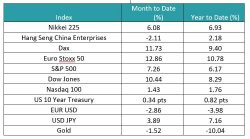MARCH MONTHLY REVIEW
A summary of key events and market trends during the month of March
- Equity rally intact, while leadership, for the moment, has switched to the S&P and Dow Jones
- Our strategy to implement stop profits across the portfolio on a number of high growth names we were holding has enabled us to come out relatively unscathed from the recent Nasdaq tumble and, more importantly, protect our capital in a time of heightened volatility and uncertainty
- For the first time since March 2020 the Volatility Index (VIX) has traded below 20 on a consistent basis
- The return to “business as usual” under the Biden Presidency is currently under-appreciated by the market, and we feel, will have a large impact on economic growth and resultantly on markets
Biden Presidency Taking Shape
President Biden gave the first press conference of his presidency and the return to normalcy is welcome
Key Markets

Recap of the month …
The month of March saw yields spiking across the US Treasury curve with the 10 Year closing the month at around 1.75 %, from 1.40 % at the end of February and 0.90 % from the end of December. Yields have moved some distance in a short period of time.
Some of the move reflects improving fundamentals centered around the re-opening of the US economy and the steady progress of the roll-out of the vaccination campaign. The other part reflects extended positioning being unwound; in the fixed income, equity and currency markets.
We expect a return to a “business as usual” approach to governance and policy under President Biden and feel that his ability to deliver the goods is currently underestimated by the market. Stating his priorities as controlling the virus, kick-starting the economy and putting it on a strong and sustainable path of growth before tackling issues such as immigration reform and gun control, President Biden has his work cut out for him.
With some 150 million doses of vaccine administered progress appears to be marginally better than initially projected and the subsequent projected ramp-up will likely see the bulk of the adult population vaccinated this quarter. Along with this, there has been initial announcements of a multi-part, multi-year fiscal support program which will address the country’s infrastructure and clean energy needs along with addressing and providing medium- to long-term employment opportunities. The funding for this fiscal package is expected to be found by raising corporate taxes as well as by applying a minimum global tax rate on companies that primarily recognize revenue off-shore.
We would expect tax increases to receive significant push-back from Republican members of Congress and President Biden’s ability to deliver this package will be a key achievement or, failing that, a stumbling block.
Globally the US Administration is seeking to re-build bridges with long-term allies and that bodes well for a multi-polar world.
We believe this more promising outlook will put a floor under the longer end of the curve, while the Federal Reserve has repeatedly anchored expectations for the shorted end.
Growth equities have under-performed this year while weak hands were shaken out of their positions and re-opening plays became the flavor of the day. Longer term we continue to favor stocks that have strong secular growth profiles and that are likely to deliver year over year growth regardless of macro policies and politics.
The news of a highly-levered hedge fund imploding does not particularly concern us; in the long-term the markets will favorably price stocks that deliver strong growth along with healthy margins and clean balance sheets. This profile of company that can deliver these metrics is typical in high-tech sectors and a result of strong product and service pipelines delivering in a consistent manner. At the same time we should continue to expect the resultant noise from the extreme market volatility surrounding these events and look to make use of opportunities as they come around; and more so as the yield curve prices in a broader economic recovery.
European and other economies continue to grapple with the virus with France heading into a month-long lockdown. The European Central Bank has had to step up its rhetoric around support for the economy and this will likely support European equities and weigh on the Euro. Elsewhere, the strengthening US Dollar sets new short-term highs across the board and primarily with the Swiss Franc and Japanese Yen.
We have been bearish on the US Dollar for over a year and went neutral as rates started rallying towards the end of last month. With the backdrop of a return to “business as usual” under a capable US President, we believe the US economy and US Dollar is under-appreciated by the market and now expect to see a strengthening US Dollar over the coming quarters.
The longer-term picture continues to evolve favorably for the US as monetary and fiscal policy supporting the macro environment and equity markets. The US Dollar will likely appreciate going forward.
